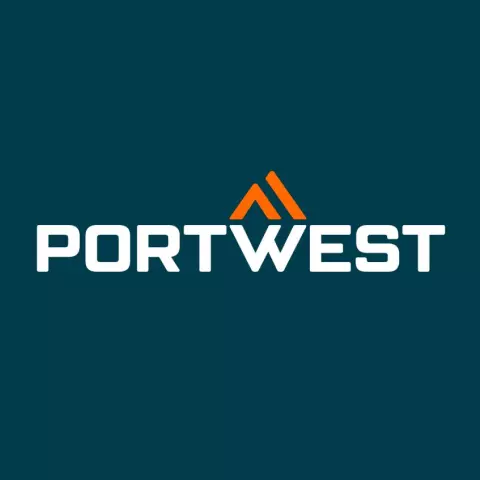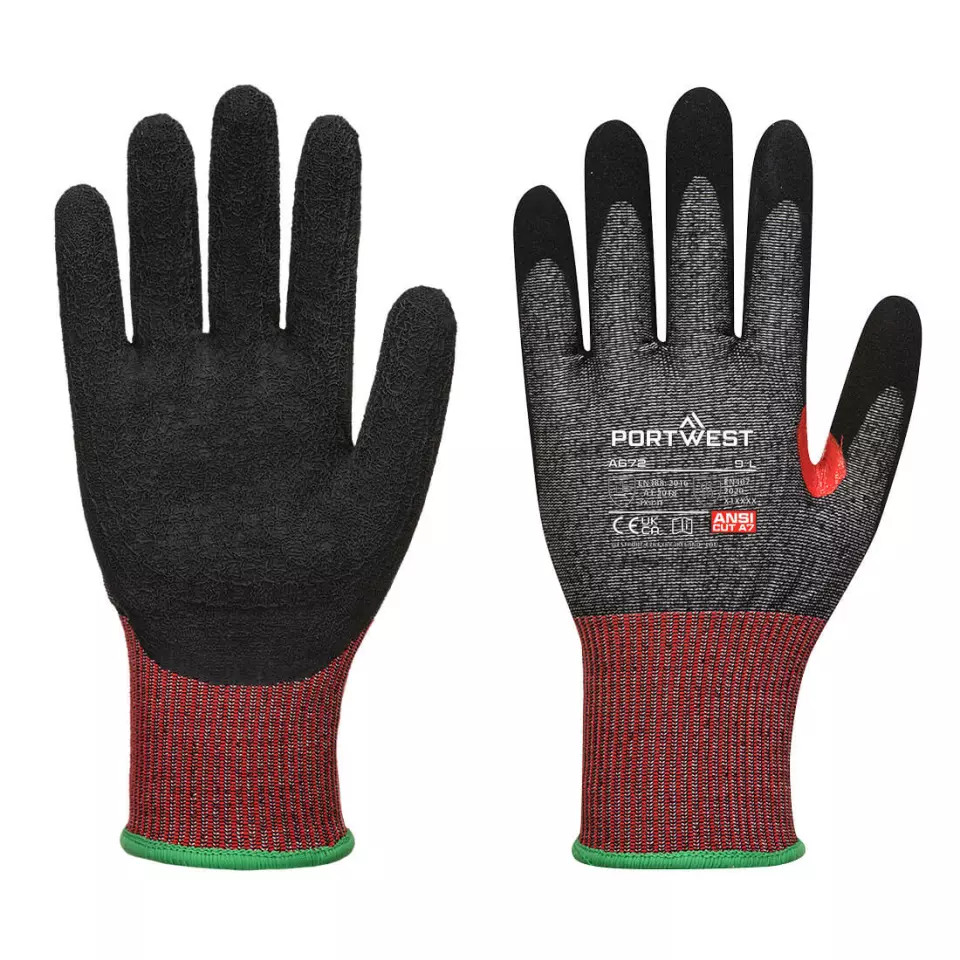Portwest CS Cut F13 Nitrile Glove, Black
Portwest
visit storeProduct description
CS cut resistant gloves offer maximum cut protection, radical low light visibility and premium cut glove features. A reinforced thumb crotch adds extra durability. Suitable for use with most touchscreen devices. The breathable 13-gauge liner ensures an excellent fit and dexterity, Nitrile foam palm coating offers outstanding grip in wet and dry conditions. Reflective label increases glove visibility in low light conditions.
Indicates the knit density of the glove, affecting dexterity and protection level. Higher numbers offer better finger sensitivity for precision tasks.
Enables seamless interaction with touch screen devices without removing gloves. Maintains productivity and protection in tech-integrated work settings.
Offers complete hand coverage, including full finger protection from cuts and abrasions. A versatile style suitable for various tasks and environments.
Indicates the glove's visual appearance, which may signify specific applications, enable color-coding systems, or enhance visibility in work environments.
Identifies the material applied to the glove's exterior that enhances grip, chemical resistance, and durability while complementing the cut-resistant core material.
Identifies reinforced areas that provide additional durability and protection in high-stress zones, extending glove lifespan while maintaining necessary dexterity.
- Hand Protection
- Cut Resistant
- Heat & Flame Resistance
- High Visibility
Request a free sample
Test first and buy later. Visit any product page to request your free sample.
Standards and labels
EN 388:2016 is a European standard for measuring the performance of protective gloves against mechanical risks (abrasion, cut, tear, and puncture). The standard includes test methods and performance requirements for gloves to be considered compliant. Test results are reported using a series of four numbers, each representing the performance level achieved in one of the tests.
Test results
Abrasion Resistance Level 4EN 388:2016 uses a specific test method to measure abrasion resistance of safety gloves; the gloves’ material is subjected to sandpaper under pressure to observe the number of cycles needed to wear through the material. Level 4 in this standard indicates that the material withstood 8,000 cycles before a hole was made. Practically, this means that gloves rated at Level 4 for abrasion resistance offer very high resilience against wearing through, making them suitable for tasks involving significant contact with rough surfaces .
Tear Resistance Level 4EN 388:2016 is a European standard that establishes criteria for assessing the protection provided by gloves against mechanical hazards, including tear resistance. The Tear Resistance Level 4 classification represents the highest level of tear resistance defined by this standard, indicating that the gloves can withstand the most substantial forces before tearing. According to the testing methodology, gloves are evaluated by measuring the force required to tear a sample of the glove material, with Level 4 requiring a force of over 75 Newtons to initiate and propagate a tear. This high level of tear resistance is ideal for use in environments where gloves are subjected to significant stress and potential damage, such as in heavy industry, construction, and handling of materials with sharp edges. Gloves achieving this level offer superior durability and are essential for ensuring user safety in high-risk mechanical settings, thereby enhancing work efficiency and reducing the frequency of glove replacement.
Puncture Resistance Level 4The standard EN 388:2016 includes a test for Puncture Resistance, where a Level 4 result indicates a protective performance that can withstand a force between 100 to 150 newtons. This specific level of puncture resistance reflects a significant protective capability, offering substantial protection against punctures from pointed objects like nails or wires. The test method includes using a standard stylus of a specific diameter, which is pressed against the sample material with increasing force until it punctures the material. A machine used for this test measures the force exerted at the moment the material is punctured. Practical implications of this result for products such as gloves or protective clothing mean that they are suitable for environments where there is a high risk of encountering medium to sharp objects that could pierce through lesser resistant materials, thus ensuring higher safety standards for workers in such conditions. This level of puncture resistance is particularly crucial in industries such as construction or waste management where sharp debris is common.
Cut Resistance, ISO 13997 Level FThe EN ISO 13997 cut resistance test, stipulated in the standard EN 388:2016, includes Level F in its rating which represents a force greater than 30 Newtons before the material is penetrated by a blade. Level F indicates excellent performance in terms of resistance to cutting, protecting against extremely sharp objects. This test is conducted using a TDM machine where a single-use straight edge blade is drawn just once across the material in a linear direction until it cuts through. The force required to penetrate the material is then measured and recorded. In practical applications, Level F cut-resistant gloves are suitable for high-risk environments such as heavy metal stamping, waste management, and glass handling, where handling extremely sharp objects and materials is common. Gloves meeting this high standard of cut resistance ensure maximum protection and durability under severe conditions.
EN 407:2004 is a European standard that specifies the safety requirements for protective gloves for thermal risks. It sets rules for the design, construction, and testing of gloves that protect users from heat and fire. Testing includes measurements of contact heat, convective heat, radiant heat, small splashes of molten metal and flame resistance. The standard also includes requirements for labeling and instructions for use. This standard is an updated version of EN 407:1994 and it's intended to protect the users against thermal risks, such as heat and flame, and to help them to choose a suitable glove for their specific application.
Test results
Heat Contact Level 1The standard EN 407:2004 on Protective gloves against thermal risks, including the testing for contact heat at Level 1, is designed to assess the protection level of gloves when exposed to thermal hazards. A Level 1 result on the contact heat resistance indicates basic protection where the glove can delay the transfer of heat from a contact source at 100°C for at least 15 seconds before the inside of the glove reaches a temperature increase of 10°C. The test method involves placing the outer surface of the glove in contact with a hot probe of defined dimensions and temperature, while the rate of temperature rise of a calorimeter on the inside of the glove is measured. This measurement provides a straightforward metric for assessing the thermal protection offered by the glove at low-level exposure. Practically, gloves rated at Level 1 for contact heat are suitable for environments where exposure to thermal risks is minimal and not excessively severe, making them adequate for certain low-risk industrial, laboratory, or handling applications where brief contact with warm objects is common.
EN ISO 21420:2020 is a European standard that sets out the general requirements for hand protection, including comfort, fit, and dexterity.
CE Marking is a label that shows a product meets certain safety and environmental standards set by the European Union. To get the CE Marking, a company must test and certify their product meets these standards. CE Marking is required for many products sold in the EU, including electronics, machinery, toys and medical devices. It helps ensure that products are safe for consumers and the environment, and allows for easy trade within the EU.
Oeko-Tex Standard 100 is a product certification program for textiles, which is awarded by the Oeko-Tex Association. This program verifies that the textile products are free from harmful chemicals. To be able to use the Oeko-Tex Standard 100 label, a product must meet certain requirements set by the Oeko-Tex Association which include limits on the levels of harmful substances such as pesticides, heavy metals, and formaldehyde. The textile products are inspected and certified by Oeko-Tex, they can use the Oeko-Tex Standard 100 label on their packaging to show that they are free from harmful chemicals. This certification is for all types of textiles, from raw materials to finished products, and it is globally recognized.
Portwest delivery terms
Free delivery for all Portwest products
84,17 €
Price per 12 pairs
7,01 € / pair
Free delivery
A package contains 12 pairs
Need larger quantities?
Other products you may like
Recently viewed
Need help?
Get help from our experts
Other products you may like
Similar products you may like
Recommended for you
Portwest
Delivery time: 3 business days
Supplier shipping fee 12,56 €
Free shipping on orders over 80,00 €



Find +150,000 products from hundreds of brands
Autonomous sourcing platform
The most efficient way to source and order supplies for your operations
Sourcing
Ordering
List products you’re looking for and we’ll find the best products and prices for you – all for free.
Need help?
Get help from our experts
